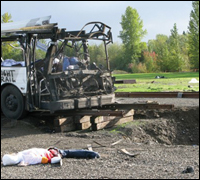Headline Archives |
|||||
| THE TOPOFF TERROR DRILL Why It Matters to Us and You |
|||||
| 10/19/07 | |||||
The victims were play acting. The blood was fake. The explosions were just for show. Even the ensuing press conferences were staged. Still, we took it all very seriously. It’s called TOPOFF 4—short for “Top Officials 4,” since it involves the highest levels of government and is the fourth event of its kind. It’s the largest terrorism exercise in the United States, meant to test the nation’s collective mettle in responding to a terrorist attack. The fabricated scenario. Terrorists snuck radioactive materials into the U.S. … then launched three nearly simultaneous strikes using “dirty bombs”—first in Guam near a power plant, then in Portland, Oregon, and in Phoenix, Arizona. Unlike conventional nukes, the bombs—called radiological dispersal devices—release radioactive materials into the surrounding areas, wreaking all kinds of health and rescue havoc. Our role. As the lead U.S. agency for terrorism investigations, it was our job to run the overall law enforcement piece, including the investigation in each venue. Along the way, we brought to bear our suite of capabilities—evidence recovery experts, SWAT teams, HAZMAT specialists, intelligence analysts, crisis managers, IT specialists, surveillance experts, bomb technicians, WMD specialists, forensic scientists, victim-witness professionals, and media coordinators.
For us, the lessons learned and experiences gained are invaluable:
"The opportunity to deploy all of our various capabilities in a real-time exercise is a great training tool," says Special Agent Rich Kolko, head of our National Press Office. "TOPOFF 4 provided an outlet to bring together our experts in one place, get them in sync, and test their ability to communicate the vast amount of information developed during the event." Operational and educational. In the end, everything we learn and improve as a result of TOPOFF makes us better able to investigate AND prevent attacks—so, most importantly, we can better protect your communities. To learn more about "dirty bombs"—from the science to the dangers—please see an informative fact sheet prepared in part by the Department of Homeland Security. |
 |
 |
 |
|
|
